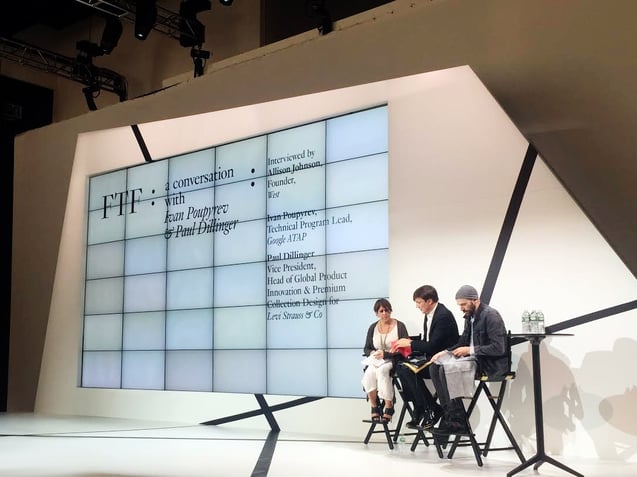Amber Kazalbash | Jun 16, 2015 9:39:57 AM
4 Min Read

In a retail landscape where ‘fast fashion’ has dominated the way customers choose to purchase, luxury apparel retailers are finding ways to differentiate and connect with audiences in new and profound ways. Last week, I was able to attend Fashion Tech Forum, a conference that brings together the digital taste-makers of the fashion industry to discuss the future of retail, e-commerce and wearable technology.
After this conference, one thing's for certain when it comes to the increasingly online world of e-commerce: a brand’s competitive edge relies on its brick and mortar presence and ability to connect personally with customers.
Brick and Mortar Is In
It seems that in the past 10 years, E-commerce has swept the retail industry. But with the over-saturation of retailers competing for the attention of users online, the actual differentiating factor could potentially be the re-institution of Brick and Mortar. One idea brought about during Fashion Tech Forum was the theme of customer empowerment. Your brand markets in a world where customers must be encouraged to interact and become ‘makers’--- of content, of visuals, and even of their own decisions. Through adding Brick and Mortar back into the mix, you can effectively build both your brand build a trusted online-to-offline community and compete in both a local and global marketplace.
Pinterest influencer and CEO of Brit & Co Brit Morin explained the competitive nature of the retail industry in terms of a customer’s attention span:
“You only have one shot to woo your audience”
With that slim of an opportunity, digging deep and building authority and culture is the only way for retailers to forge a long-lasting emotional connection with consumers. And at the end of the day, this sort of influence can’t be fully achieved with just an e-commerce dimension of retail.
Wearables Must Bridge Online to Offline
Several panelists and speakers during Fashion Tech Forum touched on the implementation of the Internet of Things and Wearables into customer life. From a sales angle, wearable functionality allows brands to map the customer journey and anticipate moments for the most contextual, personalized interaction. From a marketing perspective, wearable technology can be driven by both functionality and emotion, all of which must be anticipated in order to create in-store experiences for users. And from a design perspective, the emotional connection of wearables has never been more obvious within the fashion industry than with the Apple Watch. This wearable device was praised by several panelists who all agreed that Apple is making wearable luxuries a commodity for the connected consumer.
Paul Dillinger, VP of Innovation at Levi’s, has emphasized that with Project Jacquard the new wave of wearables will deliver clothing as omnichannel customers expect it to be. The garment will serve the use as an inconspicuous platform, not an additional device. While this sounds simple enough, bringing this sort of authenticity to clothing by fall of 2016 is what will help to seamlessly blend the Internet of Things into daily consumer life and blur the lines between E-commerce and brick and mortar.
Stores Are the New Black of E-Commerce
Because the online dimension of retail now requires users to take part in the conversation, the true layer of service actually comes into play with brick and mortar. Victor Luis, CEO of Coach explained that for a brand to develop with this mentality, it must aggressively stick to its DNA. Whether that be a long history of tradition, a solid location database, or even a service-oriented business model, finding and maintaining your brand’s DNA will generate quality, tradition and relevance within the industry as a whole.
NYU Stern Marketing Professor and CEO of L2 Scott Galloway gave an energetic session breaking down the missteps of e-commerce pure play and the opportunity for disruption through physical store locations. Brands like Macy’s and Apple are seizing the opportunity to power brick and mortar alongside with e-commerce to reach customers through every pain point of sales.
“Stores are the new black of e-commerce,” Galloway said.
From a customer perspective, the classic service layer that physical locations provide is necessary from luxury retailers. Offline is evolving in new, experimental and exciting ways, and fashion retailers should anticipate this shift to stay ahead of the competition.
If you’re a retailer looking to make sure your brand’s presence is known to local customers, don’t wait to be swallowed up by the competition. Get your free trial of Brandify today and get started on boosting your Brick and Mortar presence.
Topics: Retail

Social Media Specialist at Brandify. Home is where the Wifi is.
Offer Post Justifications Spotted in Local Results
Oct 4, 2021 8:47:46 AM
Monday Memo: More than Brands and Influencers, Consumers Trust Each Other
Sep 27, 2021 7:56:34 AM
Monday Memo: Google Adds “Latino-Owned” to GMB Identity Attributes
Sep 20, 2021 7:58:58 AM
Monday Memo: New Study Shows 94% of Consumers Use Online Business Directories
Sep 13, 2021 7:16:55 AM
Monday Memo: The Page Experience Update Has Fully Rolled Out
Sep 6, 2021 7:43:45 AM